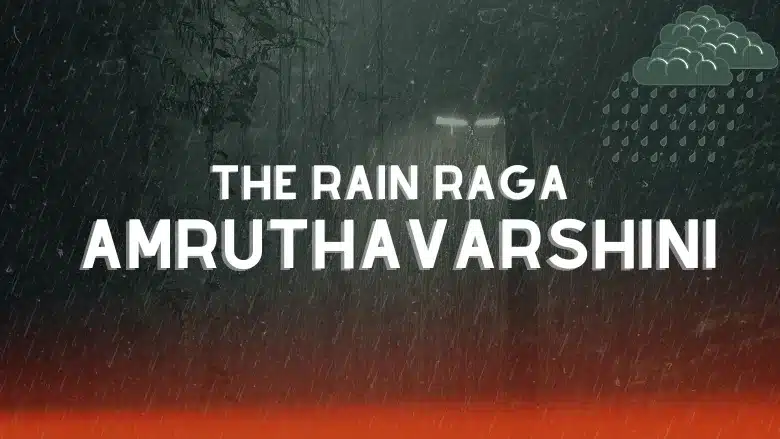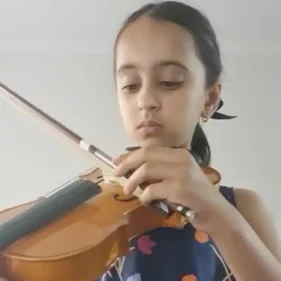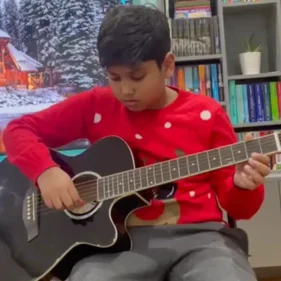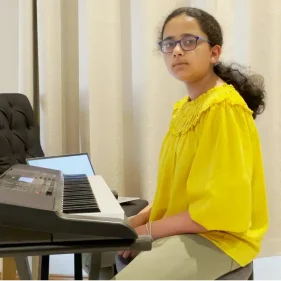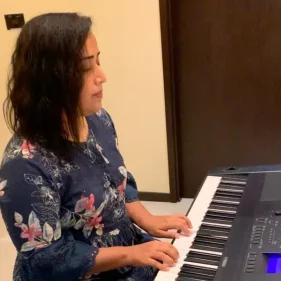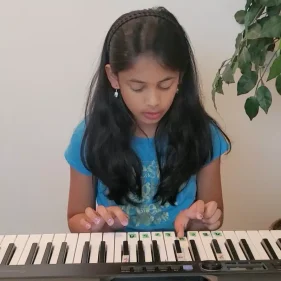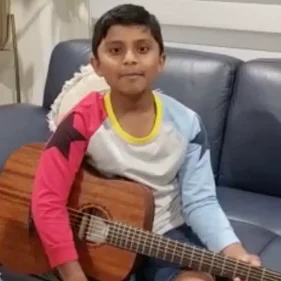Amruthavarshini means the one who showers an elixir (which provides immortality) called Amrutha. Just like the name, it is extremely pleasant to hear this scale. It is the mix of two words, Amrutha, meaning nectar in Sanskrit and Varshini, meaning the one who gives. Every child who is being taught Amruthavarshini raga brings a smile to both the teacher and the student that feels like the rain.
Lakshana and Notation
The Hindustani equivalent of Amruthavarshini raga is Megh Malhar. A symmetrical pentatonic scale by nature, this easy to identify audava audava raga has five notes excluding the Rishaba and Daivatha. It is the child of the 66th Melakartha raga, Chitambari but can however be derived from other ragas like Kalyani, Gamanashrama or Vishwambari, by leaving the Rishabam and Daivatham from the scale.
The notes or swaras of amruthavarshini raga arohana, avarohana are:
Arohanam : s g3 m2 P n3 S
Avarohanam : S n3 P m2 g3 s
Note Elaboration
Shadjam, Anthara Gandharam, Prathi Madhyamam, Panchamam and Kakali Nishadham form the framework of amruthavarshini raga notes. Experts say that the Gandharam and Nishadam livens this scale with minimal aalaps that are short, failing which the raga loses its impact. The challenging part of an Amruthavarshini performance is the jumping notes and not falling into its preceding scales like Kalyani.
Legendary Anecdotes of Amruthavarshini
I keep saying that Amruthavarshini is closely related to the rains. But is there a particular reason for it? Yes, thanks to these wonderful anecdotes. I’m going to tell you a couple of stories that make amruthavarshini raga history fascinating.
Saint Muthuswami Dikshithar, who is regarded as one of the legendary composers of Carnatic music, visited Ettayapuram, located in Tuticorin, Tamil Nadu. It was struck with drought. He went to the nearest temple, sat across the female goddess whom he considered as the all-encompassing Shakthi, and performed Anandamrutha Karshini Amruthavarshini. Legends confirm that the place got almost flooded with rain, when he was singing the Amruthavarshini raga lyrics, Salilam Varshaya Varshaya that means ‘let the rain pour’. It stopped when he replaced the same line with “Sthambaya sthambaya sthambaya”, meaning “Stop, stop, stop”.
Even the puranas signify that Ravana started to play Amruthavarshini raga on his veena after Hanuman set Lanka on fire praying to Lord Varuna, the god of rains to help him save this kingdom from burning into ashes.
Another story talks about Tansen who was asked to prove his musical prowess by singing the raga, Deepak, that is known to increase heat. Tansen took up the challenge knowing that he could burn the king into ashes in seconds, doubting his powerful weapon, his voice. The king’s daughter had learnt Megh Malhar (the Hindustani equivalent of Amruthavarshini) to cool down the atmosphere to save her father. When the oil lamps kept around started to heat up and light on its own in Akbar’s court as the legend performed a powerful song in Deepak raga, everyone got scared and the king’s daughter started to sing Megh Malhar that actually calmed the situation with cool breeze, joy, and peace.
I sometimes find it so overwhelming to learn the origins of ragas, and Amruthavarshini tops that list, so far.
Amruthavarshini Compositions
There are a variety of compositions in this exotic pentatonic scale. However, when someone starts talking about Amruthavarshini my mind starts mumbling Thoongatha Vizhigal Rendu from Agni Nakshatram or the famous Aandaamrutha Karshini Amruthavarshini kriti. Muthuswami Dikshithar’s Anandamrutha Karshini is the most famous of all Amruthavarshini raga compositions
Some of the other notable songs of this scale include Ennai Nee Maravaathe by Dandapani Desikar, the usually miscredited Sarasiruhanayane composed by Saint Thyagaraja, Eesabeku Iddu by Purandara Dasa, Aadi Varuvai Guhane of Punitasri, and Anni Mantramuli Inde Avahinchenu composed by Annamacharya.
Film Compositions of Amruthavarshini Raga
Apart from Prabhu and Amala dancing in a dreamy number of Thoongatha Vizhigal Rendu sung by K.J. Yesudas and S. Janaki, there are a couple of notable tracks. Many composers have used this raga in films of different languages, where there is an element of rain like Mazhaikku Oru Devaney from Sri Raghavendrar composed by Illaiyaraja. Naanthana Naanthana from Ninaithale crafted by Vijay Antony, the melodious Yennuyire composed by D. Imman for the movie, Annaaththe and Aashadham Padumbol from Mazha movie, composed by Raveendran, rendered by K.J. Yesudas are also set in this scale.
Amruthavarshini Healing Properties
Can you guess how Amruthavarshini helps your physical body? You guessed it right – it aids with issues related to heat. Some say that it elevates your liver health and leads to a balanced life as the raga controls the five elements present in the human body. It is also proven to cure severe headaches, indigestion, fatigue and depression.
Apart from relieving patients suffering from high blood pressure. So if you are suffering from any of the above or having a bad day, try listening to a soothing instrumental piece, in violin or flute in this scale, to feel relaxed almost instantly.
Final Thoughts
If you are already learning Carnatic music and thinking of learning kritis from your teacher after completing varnams, Amruthavarshini is a nice raga to explore. Like a hike, this scale has many twists and turns making it interesting to perform whether you are singing, or playing other instruments like Violin, or Veena. Amruthavarshini is going to calm your nerves transporting you into the land of tranquillity.
FAQs
What is Amruthavarshini raga?
Amruthavarshini is a melodious symmetric pentatonic scale (referred to as audava audava raga) in Carnatic Music, derived from the 66th Melakartha raga, Chitambari.
How to identify Amruthavarshini raga?
It is very easy to identify this benevolent raga. First of all, it is an audava audava raga which means the scale has 5 notes excluding Rishabam and Deivatham. Another way is to remember is to have a film song set in Amruthavarshini, with which you will be able to identify almost accurately.
What are the characteristics of Amruthavarshini raga?
A raga, in general, is based on a scale or pitch, with a given set of notes, with a set grammar for it to appear in a song. The basic elements of a raga can be written in the form of a scale in ascending and descending order. The unique characteristic of Amruthavarshini is its symmetrical 5-note structure that is easy to identify.
What are the Arohana and Avarohana of Amruthavarshini raga?
The arohana and avarahona of a scale is the ascending and descending order of any given scale. Here is the arohana and avarohana of Amruthavarshini raga:
Arohanam : s g3 m2 P n3 S
Avarohanam : S n3 P m2 g3 s
Note that the lowest note is represented by ‘s’ and the highest by ‘S’.
Which songs are composed in Amruthavarshini raga?
There are many interesting compositions in Amruthavarshini raga. One of the most famous tracks sung in concerts of today include Anandamrutha-karshini Amruthavarshini composed for rains to pour in a drought-stricken village located in Tamil Nadu. Another track that many reality show artists perform, is the evergreen, Thoongatha Vizhigal Rendu from the suave 80s hit, Agni Nakshatram, sung by KJ Yesudas and S. Janaki.
Who are famous composers of Amruthavarshini raga?
Some of the most famous mainstream composers who utilised the full spectrum of Amruthavarshini include, Illaiyaraja, G. Devarajan, Raveendran, and M G Radhakrishnan, to name a few. In Carnatic music, Muthuswami Dikshitar and Mutthiah Bhagavatar made waves during their time that resonate with us, even today.
How to play Amruthavarshini raga on the violin?
I’d personally recommend you to find a tutor in Music Master to teach you the basic notes and then work on improvising this symmetrical pentatonic scale. You can watch videos of legendary players like Jyotsna Srikanth (Darbar Music), Mysore Nagaraj and M Manjunath duo, and Kunnakudi Vaidyanathan to adapt their style and incorporate those techniques in your performance.
What are the famous performances of Amruthavarshini raga?
Try listening to the Online Raga Jam, or D. Srinivas in Saraswathi Veena or Megh Malhar videos that are the Hindustani music equivalent of this rainy scale.
How to sing Amruthavarshini raga?
Get trained in the basics of Carnatic Music. After you complete Varisaigal and two to three Varnams, you can request your mentor to teach you Amruthavarshini. It is easier to get started on learning from Youtube and other online courses, but learning from a teacher is more effective and systematic.
What are the notes for Amruthavarshini raga?
Shadjam, Anthara Gandharam, Prathi Madhyamam, Panchamam and Kakali Nishadham are the notes that form and weave Amruthavarshini raga together.
Related Blogs: Harivarasanam Madhyamavathi Raagam

